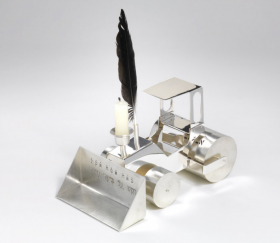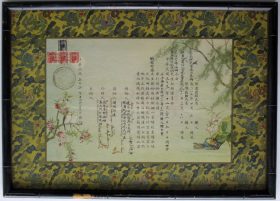Passover in Jerusalem

This miniature steamroller by the artist Avi Biran is put to work in the ritual search for leavened grain. If chametz is found in the house, it can literally make it flat as a pancake, Jerusalem 2008; Jewish Museum Berlin, photo: Jens Ziehe. You can find this and other objects related in our German-language collection database.
The time before Passover always seems a bit chaotic to me. Jerusalem looks a little like a German city just before Christmas. Everyone has off work and is busy preparing for the holiday: there is a lot to buy for the seder evening, and many people buy new clothing to look sharp for the family dinner. In homes and buildings across the city, rags, brooms, and vacuums flail frantically. This spring cleaning has a religious motivation: → continue reading
What makes Rosh ha-Shanah special
The Jewish year 5778 begins today—and with it a very special time for the Jewish community worldwide. Rosh ha-Shanah is the beginning of the High Holy Days, the Yamim Noraim (literally “Days of Awe”) as they’re known in Hebrew.
I asked around my friend group a bit to find out what Rosh ha-Shanah means to them personally: → continue reading
– How Jewish Memory Objects Preserve Chinese History

Chinese marriage certificate for Irma Bielschowsky (1902–2000) and Albert Elias Less (1887–1952), 1944; Jewish Museum Berlin, gift of Gert and Brigitte Stroetzel
I recently shared my view on several objects from Shanghai in the museum’s collection on this blog. Now, I want to draw your attention to a few marriage certificates that caught my eye not just because of their elegant design and well-preserved condition after more than 70 years, but also because I was amazed how Chinese cultural elements had entered and influenced the life of Jews who fled the Nazi rule, even though the Jews largely maintained their own cultural and educational activities in Shanghai with newspapers, Jewish schools, concerts, sport activities, theaters (e.g. Delila, Nathan der Weise, etc.), and parties (e.g. a not so sober celebration of Purim). → continue reading

